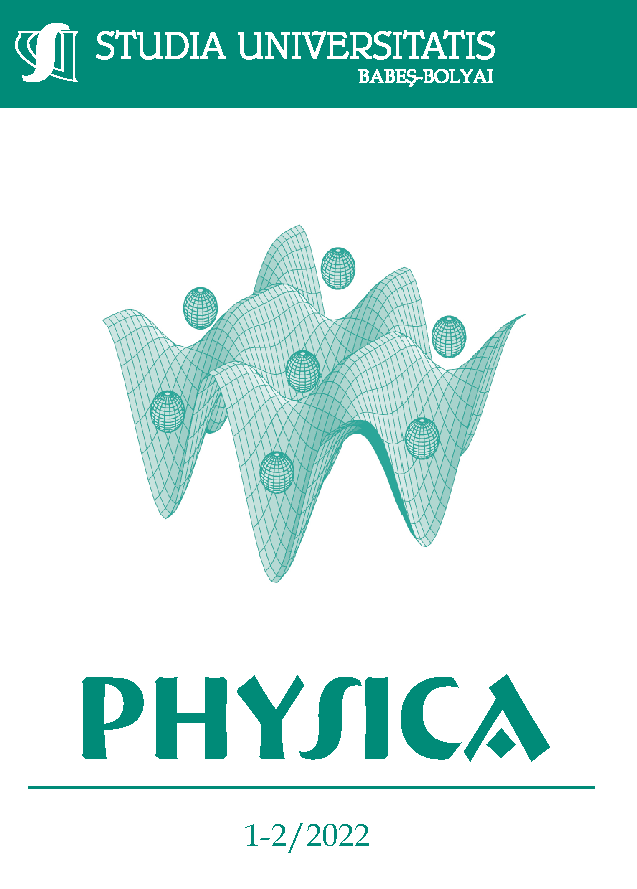RASHBA FIELD CONTRIBUTION AND ELECTRIC FIELD CONTROL OF THE MAGNETIC ANISOTROPY
DOI:
https://doi.org/10.24193/subbphys.2022.08Keywords:
perpendicular magnetic anisotropy, electric field control of anisotropy, magnetic tunnel junctions, magnetic multilayer heterostructuresAbstract
The anatomy of the Perpendicular Magnetic Anisotropy (PMA) in magnetic multilayered thin film heterostructures and the possibility to efficiently manipulate it by external electric fields represent major issues for technological applications in magnetic data storage devices. Solving a standard quantum model based on a Stoner-Rashba Hamiltonian, we illustrate that the magnetic properties in ultrathin magnetic films arise from the competing components identified in the magnetic energy: the Rashba correction to the Stoner splitting, a pseudo-dipolar contribution to the anisotropy energy proportional to the electric field at the interface that would favor in-plane magnetization configuration and a uniaxial-like perpendicular anisotropy term. This last term is responsible on the perpendicular magnetization configuration in ultrathin films and depends on the square of the electric field at the surface of the film. Investigating the time evolution of the magnetic system, we described the macrospin magnetization dynamics in terms of a Rashba field induced magnetization precession. Despite its simplicity, the quantum approach underlines the basic issues related to the physical origin and the mechanisms of the perpendicular magnetization in ultrathin magnetic films and illustrates the capability of manipulation by external gating electric field, in experiments similarly to Nuclear Magnetic Resonance.
References
B. Dieny, M. Chshiev, Rev. of Mod. Phys., vol. 89, (2017).
D. C. M. Yamanouchi, F. Matsukura, H. Ohno, Science, 301, 943-945 (2003).
S. Kanai, F. Matsukura, H. Ohno, Appl. Phys. Lett., 108, 192406 (2016).
C. Grezes, F. Ebrahimi , J. G. Alzate, X. Cai, J. A. Katine , J. Langer, B. Ocker ,
P. Khalili Amiri, K. L. Wang, Appl. Phys. Lett., 108, 012403 (2016).
E. G. V. Krizakova, G. Sala, F. Yasin , S. Couet, G. S. Kar, K. Garello,
P. Gambardella, Nature Nanotechnology, 15, 111 (2020).
R-A. One, S. Mican, C. Tiusan, Stud. Univ. Babeș- Bolyai Phys. 66, 91–110 (2021).
F. Ibrahim, H. Yang, A. Halla, M. Chshiev, Phys. Rev. B, 93, 014429 (2016).
R-A. One, H. Béa, S. Mican, M. Joldos, P. Brandão Veiga, B. Dieny, L. D. Buda-Prejbeanu & C. Tiusan, Sci Rep 11, 8801 (2021).
A. Manchon, S. Zhang, Phys. Rev. B 79, 094422 (2009).
S. E. Barnes, J. Ieda, S. Maekawa, Sci. Rep., 4, 4105 (2015).
I. E. A. Dzyaloshinskii, J. Chem. Solids 4, 241–255 (1958); T. Moriya, Phys. Rev. 120, 91–98 (1960); T. Moriya, Phys. Rev. Lett. 4, 228–230 (1960).
R-A One, S Mican, A Mesaros, M Gabor, T Petrisor, M Joldos, LD Buda-Prejbeanu, C Tiusan, IEEE Trans. on Magn. 57(6), (2021).
S. Kanai, F. Matsukura, & H. Ohno, , Appl. Phys. Lett. 108, 192406 (2016).
J. Zhang, P. V. Lukasev, S. S. Jaswal, & E. Y. Tsymbal, Phys. Rev. B 96, 014435 (2017).
Downloads
Published
How to Cite
Issue
Section
License
Copyright (c) 2022 Studia Universitatis Babeș-Bolyai Physica

This work is licensed under a Creative Commons Attribution-NonCommercial-NoDerivatives 4.0 International License.






